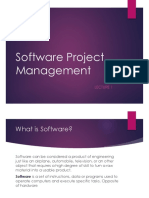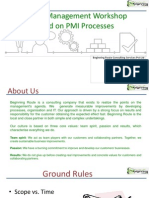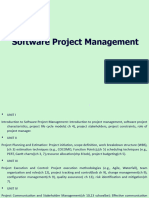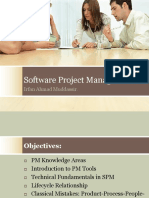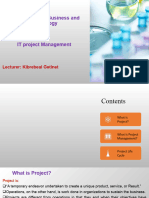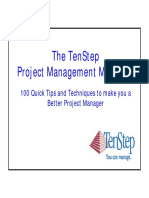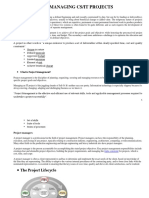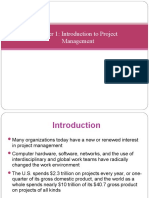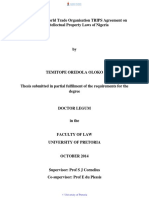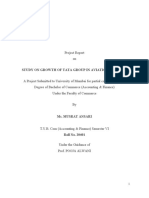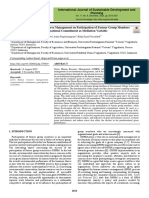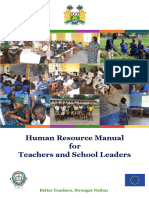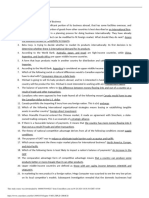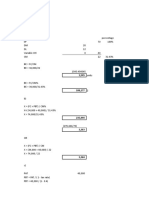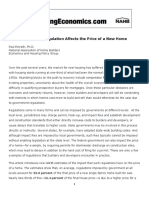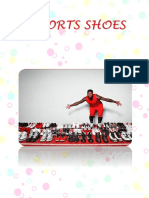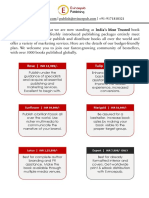Project Success Factors Guide
Uploaded by
Jordi Garcia CaballeroProject Success Factors Guide
Uploaded by
Jordi Garcia CaballeroExample: Project Success Factors
Present, based on your own experience and understanding, the factors important for the
success of a project.
We do not mean by factors: "on time", "within budget" and so on, but rather the elements,
that influence the project in a positive way.
Nr Factor Effect
Prevents scope creep, and
1 Change control
unexpected overruns
2 User involvememt Improves acceptance
3 Division between management and execution Unified approach to all projects
Faster and better decision-
4 Clear roles (tasks, responsibilities, authorities)
making
Prevents discussions afterwards
5 Scope management
and better ‘value for money’
Governance based on ‘value for money’ / the The money to be spent is well-
6
Business case considered
Prevents teams to be de-
motivated in advance and
7 Realistic planning
prevents customer from having
unrealistic expectations
Management from the business perspective Better assurance of customer-
8
instead of from the supplier; powerful Executive interests
Prevents conflicts during project
9 Priority setting between projects
execution
Etc. (see also the Chaos Report by the Standish
10 Etc.
group)
These are just a few examples!
© Lagant Example Project success Version 17.0, Aug. 2017 Page 1
Example: Outline business case
Based on the case ‘Laurel & Hardy’; project-1
1. What benefits may be expected?
• Improved collaboration
• Corporate image
• Affiliation with desired image
• (better accessibility)
• (advanced and functional)
2. What are the possible options ?
3. What is roughly the effect of each of these options, in terms of risks and costs (type)?
• Do nothing
• Have a new building designed and constructed
a. Costs (and time) for the design
b. Costs (and time) for licenses and purchasing the building land
c. Costs (and time) for construction
d. Costs equipment, furnish and relocation
e. Risks: late delivery due to license procedures, weather conditions.
• Purchase existing building
a. Selection existing building (requires time & money)
b. Purchase building, possibly refurbishment en/of reconstruction
c. Costs equipment, furnish and relocation
d. Long term investment, high start-up costs, longer payback period?
e. Risks: Is a suitable building available within budget and in short term?
f. Risk: hidden defects
• Hire/lease existing building (short/long term)
a. Selection existing building (requires time & money)
b. Contract negotiations, possibly reconstruction and/or refurbishment
c. Costs equipment, furnish and relocation
d. Short term investment, low start-up costs, terminated relatively flexible
e. Risk: hidden defects
4. Are there also negative effects(dis-benefits) ?
5.
• For certain employees the distance will be greater.
• For certain customers the distance will be greater.
© Lagant Example business case Version 17.0, Aug. 2017 Page 1
Example: Project Organization
Below you will find a number of responsibilities. Specify per responsibility to which role this
belongs to:
PB Project board EX Executive PS Project support
PM Project manager SU Senior user PA Project assurance
TM Team manager SS Senior supplier
Nr Responsibility Role
1 Provide current status information on all products PS
2 Ensure that the scope of the project is not creeping upwards unnoticed PA
3 Establish and manage the project controls (monitoring and reporting) PM
4 Ensure that supplier resources required for the project are made available SS
5 Conduct configuration audits PS
6 Direct, plan and monitor the team’s work TM
7 Ensure the desired outcome of the project is specified SU
8 Approve Product Descriptions for supplier products SS
9 Commit project resources required for the next Stage Plan PB
10 Brief corporate or programme management about project progress EX
11 Ensure that the Business Case is being adhered to PA
12 Ensure that the appropriate entries are made in the Quality Register TM
13 Review issues and risks by assessing their impact in the Business Case PA
14 Administer Change Control PS
15 Ensure that any user resources required for the project are made available SU
16 Monitor the business risks EX
17 Set up and maintain project files PS
18 Ensure that the right people are being involved in quality inspections PA
19 Approve changes CA
20 Resolve supplier requirements and supplier priority conflicts SS
21 Establish and manage the project’s risk management procedure PM
22 Collect actuals data and forecast PS
23 Manage the production of the required products PM
24 Brief and advice user management on all matters concerning the project SU
25 Prepare plans for the team’s work TM
© Lagant Example Organisation Version 17.0, Aug. 2017 Page 1
Example: Project start
Roadmap (just an example)
1. Inventory of the initial situation, study documentation already existing.
2. Inventory of steps already taken
3. Check support of management involved.
4. Check mandate (formally appointed) executive (by higher level of mgt / same level of
mgt).
5. Project manager role to be appointed formally.
6. Carry out environment analysis (see also step 24; input for risk identification).
7. Carry out stakeholder analysis and set up outline for communication plan
8. Business case outlines (financial / economic / strategic, guidelines for investment
analysis within the organization).
9. Discuss ideas about the benefits management approach.
10. Determine nature of the project (stand-alone, enabler for other projects, strategic, part
of programme etc.).
11. Discuss accountability about SU process costs.
12. Check constraints (budget, time, resources).
13. Design the project board.
14. Set up and discuss the job descriptions.
15. Establish the project approach, select the senior supplier and draft the stages.
16. Appoint senior supplier, senior user, project assurance (if applicable).
17. Check need for project support and if yes, set it up.
18. Arrange a start-up meeting if required.
19. Record goals, objectives, expectations, acceptance criteria.
20. Appoint team managers if required.
21. PMT and project approach agreed ?
22. Draft the project brief (scope, results, expectations, acceptance criteria and outline
BC).
23. Check support other stakeholders.
24. Carry out global risk identification; update project brief and daily log.
25. Project brief approved?
26. First communication (first bulletin ..?)
27. Set up the initiation stage plan.
28. Initiation stage plan approved?
PS: These steps are a mix of PRINCE2 processes, activities, roles, products, and "common sense".
© Lagant Example Project start Version 17.0, Aug. 2017 Page 1
Example: Project Assurance
1. Name 3 general project assurance tasks;
2. Name 3 business assurance tasks;
3. Name 3 user assurance tasks;
4. Name 3 supplier assurance tasks;
5. Describe the skills that are required.
General: See Manual; Appendix C: Roles and responsibilities; C7 Project Assurance.
Remark: People with PA tasks must act absolutely independent from the project manager;
therefore the project board cannot delegate any assurance activities to the project
manager.
Ad 1 General assurance responsibilities:
Assure:
• That the interrelations and interactions between the business, user and supplier are
maintained well during the course of the project
• Risks are managed
• The right people, with the right skills are involved in the creation of the product
descriptions
• The right people, with the right skills are involved in quality inspections
• The people involved are sufficiently trained in quality methods
• etc.
Ad 2 Business assurance:
• Support the PM in drafting the business case en the benefits management approach
• Advise in the selection of the project management team
• Advise on the risk management approach
• Review the business case on corporate or programme standards & procedures
• Check whether the business case is regularly updated during the course of the project.
• Etc.
Ad 3 User assurance:
• Advise on Stakeholder management
• Advise on the change control approach
• Assure user specifications on completeness, accuracy and being unambiguous
• Review if the solution meets the user needs and if it is developing into that direction
• Advise on changes from the users perspective
• Etc.
Ad 4 Supplier assurance:
• Review product descriptions
• Advise on the quality management approach and change control approach
• Advise on the selection of the development strategy, design and methods
• Assure that all applicable standards for the supplier and for operations are used and
applied correctly
• Advise about changes from the suppliers perspective
• Etc.
© Lagant Example Project assurance Version 17.0, Aug. 2017 Page 1
Example: Project Assurance
Ad 5 Competences:
• To be able to represent the interests of the business, user or supplier
• Building up sufficient credit to have the given advise accepted and enforced
• Sufficient specialist knowledge about the area of the business, user, or suppliers
• Ideally, being available throughout the project
• Important personal qualities like::
o Diplomacy
o Accuracy
o An eye for detail
o Communication
Note: the above is not a complete list from the manual.
© Lagant Example Project assurance Version 17.0, Aug. 2017 Page 2
Handout: Product based planning
On base of the case ‘Laurel & Hardy’; project 2
Excerpt from the interview with the senior user:
"For the new mortgage application a number of matters is still to be dealt with. As part of the design, a
solid, optimized inventory should be made of the data-model of the various processes, interfaces, and
functions. Function analyses should be performed for all functions, that will ultimately lead to an
analysis of individual training needs for the department’s staff. Interfaces (with the ledger application,
the insurance application, the CRM application and the BKR) should be discussed and agreed with the
application administrators concerned. The function descriptions should give clarity about the required
knowledge, skills, attitude and experience of every employee, and should indicate the function-scale;
both the entry-level and top-level.
To do this, a training programme and an education plan should be made. The training plan must be
known by the end of month 6 at the latest, so it can be taken into account when the department's plan
is developed in month, 8 and 9. If necessary, a number of temporary employees could be hired to
compensate for the loss of capacity due to education and training.
The design of the application and the optimized business processes (both the front- and the back-
office) should be approved by both I&A and P&O before we move on to the realization and
implementation. I&A, made it clear to me that in any case, the application must comply with the
corporate IT architecture and the IFRS guidelines. Within 10 months all the staff of the Department (#
68 employees) should be trained. It is expected that we should develop a different scheme for the front
office staff than we did for the back office staff. My idea is to setup and start an experimetal labaratory.
In the meantime, we need to consult with the Workers Council whether the new job descriptions fit
within the existing function groupings. We must also ensure that new employees in the future can take
the training individually.
I also understand from our internal IT Department (part of I&A),that at the end of the design process it
becomes possible to establish a reliable budget estimate for the further system development by
applying function point analyses. In addition, they demand that a test plan is ready by the end of month
6, and by the end of month 7 a test environment will be delivered. In the test environment the following
items will be tested separately:
• The interaction with the customer (front office)
• The internal processing and handling (the back-office) Included in the
product description of
• The management reporting
the test environment
• The interfaces
• The risk analysis and portfolio analysis and internal audit reports
•
As a member of the Project Board, I think we also need to look seriously at project reporting. I have
often said that I am totally dissatisfied with the current set-up. I’m simply not able to work through a
report of 5 pages per project. Consequently, the current reporting is too detailed and therefore not
adequate. "
This passage describes
management products
Notes:
(underlined/red = integration/simple product/double-underlined/purple = external product)
(‘realization’ and ‘implementation’ explain the various stages of a product).
(“a reliable budget estimate for the further system development by applying function point analyses” will
be useful in managing a stage boundary, in this case to prepare a stage plan ).
© Lagant Example PBP Version 17.0, Aug. 2017 Page 1
Handout: Product based planning
Product Breakdown Structure
1.0
Mortgage application
1.1 1.3 1.4 1.5 1.6
Overall Design Group Group Group Group
Start Documentation Education Process Applications
1.1.1 1.4.1 1.5.1 1.6.1
1.3.1
Design Interfaces Training programme Optimized Business Mortgage Application
IT
Process Delivered
Architecture
1.1.3 1.4.2 1.5.2 1.6.2
Design Data Model Education Plan Implemented Mortgage Application
1.3.2 Processes Implemented
Existing
Function
Groupings 1.4.3 1.5.3
1.1.4 1.6.3
Group Group
Design Functions Test Plan
Trained Staff Function Descriptions
1.3.3
1.1.5 IFRS
1.6.4
Design Application Guidelines
1.4.3.1 1.5.3.1 Test Environment
Trained Front-office Function Descriptions
staff Front-office
1.2
Group 1.4.3.2 1.5.3.2
Interfaces Trained Back-office Function Descriptions
staff Back-office
1.2.1 1.4.4
Ledger Interface Experimental
Laboratory
1.2.2 1.4.5
Insurance Interface Education Needs
1.2.3
CRM Interface
7 Product Groupings
1.2.4
BKR Interface
24 Products
3 External Products
© Lagant Example PBP Version 17.0, Aug. 2017 Page 2
Handout: Product based planning
Product Flow Diagram
1.3.1 1.3.2 1.3.3
IT Existing IFRS
Architecture Function Guidelines
Groupings
1.5.1 1.1.5 1.1.3 1.1.1
Optimized Business Design Application Design Data Model Design Interfaces
Process
1.1.4
Design Functions
1.1
Overall Design
1.5.3.1 1.5.3.2
Function Descriptions Function Descriptions
Front-office Back-office
1.4.5 1.6.3 1.2.2 1.2.1
Education Needs Test Plan Insurance Interface Ledger Interface
1.6.1 1.2.3 1.2.4
1.4.1 Mortgage Application CRM Interface BKR Interface
Training programme Delivered
1.4.2 1.6.4
Education Plan Test Environment
1.4.3.1 1.4.4 1.6.2
Trained Front-office Experimental Mortgage Application
staff Laboratory Implemented 1.5.1
Optimized Business
Process
1.4.3.2 1.5.2
Trained Back-office Implemented
staff Processes
1.0
Mortgage application
© Lagant Example PBP Version 17.0, Aug. 2017 Page 3
Handout: Product based planning
Product description ‘Function Description Back Office employee’
Subject Description
Identifier PD_Funcd_mort_FS7.62_V1.0
Title Function description employee Back Office Dept. Mortgage provision.
(funct.descr.back)
Purpose Clear and unambiguous tasks, responsibilities and competences. Clear
reporting lines. Management authorities and span of control included
Composition 1. Demands on:
a. Knowledge
b. Know how
c. Attitude
d. Experience
2. Function scale and salary group
a. Entry level
b. End level
3. Tasks, Responsibilities and competences
4. Place in the organization
Derivation P&O, HRM, WC, existing function scales, optimized business process
Format & Conform Template_Funct_V3.4.dot, Language: dutch
Presentation
Development skills Projectteam Proces & Organisatie
required
Quality criteria Conform format existing function scales and salary groups.
In-line with optimized business process.
The education needs should be derived from the gap between the existing
and the new function description.
Simple and clear language (High school level)
Quality tolerance The new salary group may be max 2 salary groups higher or lower than
the current, but should always remain within the existing function scale.
Quality method Minimum of 2 reviews on behalf of P & O and WC.
1. First draft agreement after optimized business process, especially
for composition paragraph 1 and 2
2. Final version, including composition par. 3 and 4.
Quality skills required Knowledge of existing job descriptions and optimized business processes,
Knowledge of business strategy and HR policies
One of the reviewers must be member of the WC.
One of the reviewers should be employee of P & O.
Quality Formal agreement by Director P & O
responsibilities
© Lagant Example PBP Version 17.0, Aug. 2017 Page 4
Example: Management of risk
Based on the case ‘Laurel & Hardy’; project 2
It is still unclear whether the staff of the Department, Mortgage-Control can free up sufficient time for
the training, within the timeframe scheduled. The Manager of the Department has indicated that (worst
case), the timeframe might be exceeded by 1 month. If that happens the training facilities need to be
rented also 1 month longer.
Make a full risk analysis.
Risk identifier R0012/version 1.0
Author Frits van der Valk
Date registered xx-yy-2017
Risk category Project Human Resource
At unpredictable moments, there is an overcrowding in the mortgage provision department and
only a limited number of employees can attend the training simultaneously. As a consequence, the
duration of training for the Department will take 1 months longer than planned. The effect will be
that the training facilities need to be rented for a longer period. Because the trainings are not part
Risk description
of the critical path, there will be no effect on the total duration of the project.
Probability Probability is 35%
Impact Extra costs for renting education facilities ad € 10.000,= per month
Expected value Financial: 0,35 * € 10.000 = € 3.500,=
Time: 0,35 * 20 days = 7 days.
Proximity Risk occurs in stage 4.
Accept
Risk response
categories
In the Stage Plan for Stage 4 (in which trainings are planned) the Risk Tolerance is extended with
€ 3.500,= and 7 days duration
Risk response
Risk status Active
Risk owner Manager Education Dept. Reports about the expected workload in his department
Risk actionee TM Education Extend the trainings facilities for the maximum of 1 month extra
© Lagant Example Risk Version 17.0, Aug. 2017 Page 1
Example: Project Situations 1
Projectsituaties 1
1. This is called a "project issue". So you have to investigate: What is the impact on the
plan and the BC? Does the lead to new risks?
This is the customer’s responsibility. Report the effects through an exception teport. In
any case, do not use your tolerance for this. This issue is probably a contract issue that
should be resolved between the senior supplier and the executive. Make sure that you in
your PM role will not become the ‘victim’ of this situation.
2. This is also a project issue; a potential risk (if there is a chance of recurrence). Tasks are
probably not on the critical path.
Discuss this with the senior supplier, it is ultimately his problem! This is an example of
addressing one of the members of the project board for advice; The customer is not a
party in this issue (yet); it is the senior suppliers responsibility to solve this. That means
that the plan might be exposed beyond tolerance if this is not resolved timely and
satisfactory. This might lead to an exception report to the project board.
3. A project issue, which calls for further investigation, followed by an exception report to
the project board (triggering giving ad hoc direction). The senior supplier must fix this (so
preferably contact him in advance). This may become a risk to the entire project.
4. Borderline; is this really a project issue?
This may be symptomatic. Capture this in the daily log to monitor if it happens again. (if
there is a dustpan and brush available, solve it yourself; less costly than escalation).
5. This is a risk to the product life cycle, so a benefit risk. This requires consultation with
the project board,
Do we have more information?
What is the impact?
No adjustments to make yet!
Await the decision of the project board.
6. As PM try to resolve it yourself. Otherwise this is to be reported. Capture it in the issue
register. If we foresee similar problems in the future, we also make an entry in the Risk
Register
Back to the senior user who is responsible for resolving this issue.
Be aware of the remaining tolerances!
N.B. A Project Issue might be:
- Request for Change
- Off-Specification
- Problem / concern
© Lagant Example Situations 1 Version 17.0, Aug. 2017 Page 1
Example: Configuration management
You are the project manager of a project to construct and deliver a new office building (newly
constructed) for your organization.
During the execution of the preparatory groundwork (phase 2) the Executive Board decided
to come back to the already approved drawing. At first they had decided to place the
entrance of the building in the middle of the south front. After reconsideration they want to
move the entrance of the building to the corner of the south and east façade (see sketches
below).
Old situation New situation
building building
P- P-
Pers. Pers.
R R
W W
. T1 . T1
P-Guests T2 P-Guests T2
R = Reception
W = Waiting room
T1 = Access path from parking space
T2 = Access road cars
The following products should be updated,(after applying the change control procedure):
• The PD's for ground work, Building, Reception, Waiting, T1, P-Staff and P-Guests
• The product 'Drawing'
• The product 'ground work'
• The product 'building permit'
• The current work package 'executing Groundwork’
• New work package for "update drawing’
• New work package for "New application for building permit’
• Possibly the acceptance criteria
• The product checklist in the plans (possibly different dates)
• The stage plan (additional / renewed reviews and quality checks, adjusted and new work
packages, higher costs and extended duration?)
• Possibly the project plan (depending on the impact and tolerances), because products and
effort in future stages also might be affected
• The business case, since it leads to additional costs or benefits
• If there is a change budget, the extra costs should be debited
• The relevant configuration item records
The quality register, issue register, lessons log and the risk register are excluded because they
normally are excluded from configuration management.
© Lagant Example Configuration Management Version 17.0, Aug. 2017 Page 1
Example: Project Situations 2
Project situations 2
1. The chair (chairperson). There is a disagreement between the reviewer and the presenter. The
chair should not have let this happen. He / she is as chairman process-responsible (he is not a
reviewer!). A follow-up action should be taken.
2. Project issue. Forward this to the executive. Initially this is not an RfC because it is outside the
scope of the project. Moreover, they are not in the position to make such a demand or give any
directive, since I report to the Project Board. The quality management approach is baselined.
So they can submit an RfC. For management products preferably change control is applied.
3. This may affect your BC (extra costs). Should be reported to the project board as a project
issue, including your assessment of the impact on the project. The Project Board
communicates to the outside world of the project.
4. This project issue is an off-specification, and should preferably be resolved quickly.
Tolerances cannot be used because it is a delivered (baselined) product.
Escalate this as a project issue to the change authority, and await its position.
The change authority could make a concession, but it this case it likely not to be applicable.
The impact on the contracts terms and conditions (e.g. fixed price/fixec date) are to be
discussed by the project board.
5. Risky! This should have been handled as a RfC. If this happens frequently, it can easily lead to
te a scope creep. Reverse the change if possible and handle the request as an RfC/formal
issue.
At this moment the product will not pass the quality check, because the product differs from the
Product Description.
6. Handle this in accordance with the change control procedure (part of the PID). Perhaps this can
be handled smoothly when the RfC is contributing clearly to the business case and the change
authority allows its funding from the change budget. Any extra time for its development is to be
obtained via an exception report. The impact on the contracts terms and conditions (e.g. fixed
price/fixec date) are to be discussed by the project board.
© Lagant Example Situations 2 Version 17.0, Aug. 2017 Page 1
Example: PMT situations
Below are a number of brief scenarios. Point out for each scenario, how in your opinion the
project management team should be composed. Assumptions are allowed as long as these
are explained.
From the perspective of the sponsor this is to be managed as one single project. Sometimes
multiple alternatives are possible. Work out no more than two alternatives.
Scenario 1
You are working in a medium-size organization. As a project manager, you are responsible
for moving to a new head office and to sell the old premises through a real estate agent. You
will report to the Commercial Director. The construction is finished and delivered by the
contractor, but it still has to be refined and equipped. This will be carried out by a real estate
developer. For the moving of furniture, materials and equipment a professional remover is
contracted.
Ex Commercial Director
SU Property manager (new building) + Real estate agent (building to be sold)
SS Contractor (1st en 2nd delivery), Real estate developer, Remover
PA Property manager
PM You
PS You
TM Real estate developer, Remover, Contractor
Scenario 2
You work for the ICT Department of a large bank. As a project manager you are responsible
for the migration of the existing network to a new operating system. This is to be rolled-out to
all offices of the Bank in the Pennsylvania. Your Department hires about 50% of the
professionals through several ICT suppliers. Hardware and software are always purchased
by vendor BMI. Your department consists of sub-departments on project management,
development, technical management, application control and network management. The
Bank has a central department for Facility Management and Technical Maintenance. Your
Department has agreed and signed off SLA’s (Service Level Agreements) with the various
offices about delivery of all ICT services.
Ex Corporate Board member
SU Facility Manager, Manager SLA’s
SS Manager ICT-department, Account Manager BMI
PA Manager SLA’s
PM You
PS Departmental secretary + configuration manager of Application control
TM TM Application Control, TM Network Control, TM BMI
© Lagant Example PMT situations Version 17.0, Aug. 2017 Page 1
Example: PMT situations
Scenario 3
You are a Project Manager, working for a large software house in the division Financial
Institutions. A large bank wants a new web-based mortgage application, running on the
existing infrastructure from (trademark) PacCom. The Bank does not have the technology yet
for developing web-based applications. The application will be build by your software house
and handed over to the ICT Management Department of the Bank after it has been
developed and will be used by staff of all the bank’s offices, the staff of the Central helpdesk
on one of the large call centres and ,last but not least, also by the bank’s customers. Your
organization decides to offer a fixed-price. The application should be linked to the existing
business information system. All the Bank’s personnel working with the new application, shall
be trained.
Ex Corporate Board member Bank
SU ICT-Operations, Manager Mortgage Services, Manager Training & Education
SS Contract manager software house
PA Somebody from the Internal Controllers office ?, senior-PM from the Bank,
senior PM from the software house (in relation with fixed price)
PM You
PS junior PM’s from the software house, ICT-Operations for configuration mgt
TM TM Development, TM Operations, TM Education & Training,
TM communication (with clients), TM call centre
Scenario 4
You are working for a Management Consultancy Provider. One of your customers; a large
industrial organization has asked your organization to assist in the introduction of the
logistical modules of the package PSA for the Departments, Purchasing, Production,
Warehousing, Sales and Distribution. The P&O Department manages the changes in the
relevant business processes themselves, and ask you to manage the implementation of the
PSA package. The software is purchased through BMI (one of the preferred suppliers of this
package in the Netherlands). Consultants of the software provider Intellihouse will support
the adaptation of PSA to the existing processes within the organization. In order to operate
and maintain the PSA package, a number of professionals of the Department ICT Operations
will be trained.
Ex Corporate Board member Customer
SU Corporate Board member Customer or ICT-manager Customer, Manager ICT-
Operations
SS Acc Mgr Intellihouse, Product Mgr BMI, Acc Mgr Consultancy provider
PA P&O, independent P2 expert
PM You
PS Junior colleagues consultancy provider, ICT Operations for configuration mgt
TM TM customizing, TM implementation, TM training
© Lagant Example PMT situations Version 17.0, Aug. 2017 Page 2
Example: PMT situations
Scenario 5
You work for the Project Office of a large organization in the food industry. Regularly the
R&D Department develops new products. You are responsible for an 'umbrella project ". This
includes the development of a new product and to make it ready for initial marketing,
production and distribution. The Organization has a separate QA department, which monitors
the quality of products and production processes. Budgets for projects of this kind are
provided by the Chief Executive. The ideas for new products coming from the Marketing and
Sales department, which appoint an ’idea-owner’. This idea-owner is normally the product
manager of the new product. Production and distribution you should agree with the head of
the Department Operations.
Ex Chief Executive
SU Product Manager, Head of Production
SS R&D
PA QA department, senior professional project office
PM You
PS Employees from the project office
TM TM R&D, TM Marketing, TM Sales, TM Operations
Scenario 6
You work as a project manager for a large real estate developer. You are responsible for the
construction of a new residential area near Philadelphia. This new residential area is in a
former agricultural area. At this time a soil survey is performed by contracted Engineering
Office. The area include a number of homes for sale, and a number of dwellings to be rented
out. The drawings of the several types of houses are ready and approved by the local
government, but there is still a lot of resistance by residents and Environmental Groups, in
particular against the reduction of the groundwater level beneath the residential area. People
fear adverse consequences for a nearby area. Also there is a lot of resistance against the
construction of streetcar track, because it is a (scarce) rural area. A park is planned on the
edge of the district, surrounded by a small number of villa's. For these villa's, the buyers of
the ground are allowed to create their own drawings, but are obliged to contract out the
actual building to your organization. The construction are contracted out to specialized firms
(ground workers, road workers, contractors, installers, painters, etc.).
Ex Director real estate developer
SU Representative of a user committee, consisting of representatives from the local
government, representatives of interest groups, representatives of future occupants
(renters, buyers of property) representatives of villa buyers (possibly all together in a
‘user board’ and represented by a Senior User)
SS Contract managers suppliers
PA QA dept real estate developer, representative of the local government
PM You
PS employees
TM TM’s of all suppliers
© Lagant Example PMT situations Version 17.0, Aug. 2017 Page 3
Assignment: Management products
Match the descriptions with the corresponding management products.
Purpose of the product … Management product ?
1 Used to record problems/concerns that can be handled by the Project Manager informally. Daily log
2 The justification for an organizational activity (project), which typically contains costs, benefits, Business case
risks and timescales, and against which continuing viability is tested.
3 An informal repository for lessons that apply to this project or future projects. Lessons log
4 A progress report of the information gathered at a checkpoint, which is given by a team to the Checkpoint report
Project Manager and which provides reporting data as defined in the work package.
5 A description of the means and frequency of communication between the project and the project’s Communication management approach
stakeholders.
A plan that defines how and when a measurement of the achievement of the project’s benefits can
6 be made. If the project is being managed within a programme, this information may be created and Benefits management approach
maintained at the programme level.
A record that describes the status, version and variant of a configuration item, and any details of
7 important relationships between them. Configuration item record
8 A description of how and by whom the project’s products will be controlled and protected. Change control approach
The set of information relevant to the creation of one or more products. It will contain a
9 description of the work, the product description(s), details of any constraints on production, and Work package
confirmation of the agreement between the project manager and the person or Team Manager who
is to implement the Work Package that the work can be done within the constraints.
A report given by the project manager to the project board, that confirms the handover of all
10 products and provides an updated business case and an assessment of how well the project has End project report
done against the original Project Initiation Documentation.


